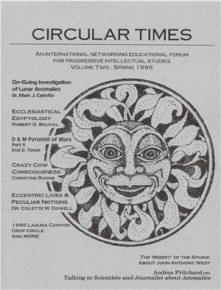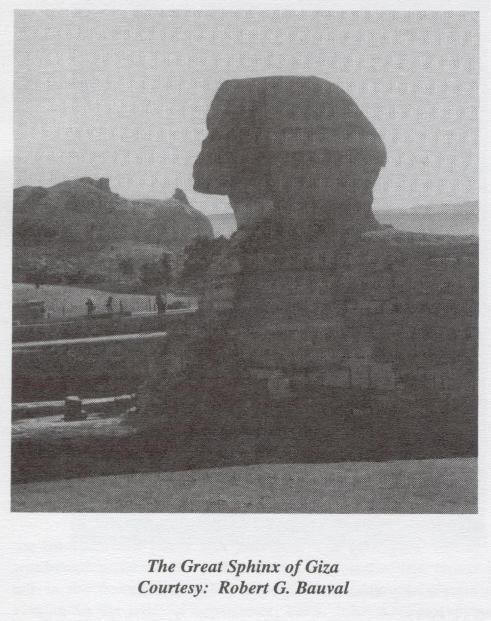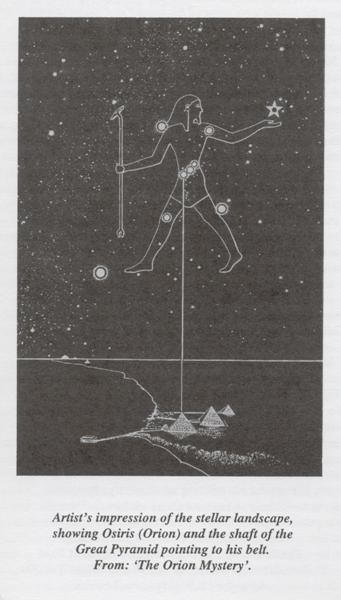 HERESY !
HERESY !CIRCULAR TIMES EXCLUSIVE: by Robert G. Bauval - 1996
 HERESY !
HERESY !
Reprint From Circular Times Volume Two : Spring 1996
The 'Heretics' of Egyptology
Since early 1993, the international public has been made aware through a vast media campaign of three major discoveries about the Three Great Pyramids and the Great Sphinx of Giza that could change our perception of the origins of civilization forever. RGB
ECCLESIASTICAL EGYPTOLOGY
By Robert G. Bauval © 1996
These three major discoveries are, in chronological order: (1) The geological dating of the Great Sphinx by John Anthony West and Robert Schoch (2) The discovery of a ‘door’ with a mini-robot inside a shaft of the Great Pyramid by Rudolf Gantenbrink (3) The discovery of a star-based mapping of the three Giza Pyramids by myself.
These discoveries, however, are regarded as the product of extreme heresy in Egyptological circles and, in a more general manner, in the halls of academia. The reasons are these:
1) The Age of the Sphinx
 John
A. West, an amateur Egyptologist and author, and
Robert Schoch, an
eminent geologist from Boston University,
have claimed that the vertical
fissures and undulated erosions on the Great Sphinx of Giza and its enclosure
were caused not by wind and sand, as Egyptologists say, but by ‘water
precipitation-induced weathering’ (i.e. rainfalls) which stopped occurring in
this region of the Sahara at least
7000 years ago.
John
A. West, an amateur Egyptologist and author, and
Robert Schoch, an
eminent geologist from Boston University,
have claimed that the vertical
fissures and undulated erosions on the Great Sphinx of Giza and its enclosure
were caused not by wind and sand, as Egyptologists say, but by ‘water
precipitation-induced weathering’ (i.e. rainfalls) which stopped occurring in
this region of the Sahara at least
7000 years ago.
The conclusion: The age of 4500 years ascribed by Egyptologists to the Sphinx is wrong. The Sphinx is much older; anything between 5000 BC to 15,000 BC.
The implications: The ancient Egyptian civilization as described by Egyptologists could not have built the Sphinx since, according to the latter it was not yet in existence 7000 years ago.
Media reaction: Dozens of articles have appeared in the international press and journals. The geological thesis was broadcasted on November 10th, 1993, on the NBC channel, in the documentary, Mystery of the Sphinx, and a new version on the BBC in September, 1994. John A. West won an EMMY for best research for a TV documentary.
2) The 'Door' in the Great Pyramid
In March 1993, Rudolf Gantenbrink, a free-lance graphic and robotics engineer, explored with a mini-robot the two narrow (23 x 22 cm) shafts emanating from the so-called Queen’s Chamber in the Great Pyramid and found that they penetrated much deeper than Egyptologists had believed. At the end of the southern shaft was discovered a ‘door’ complete with two copper handles; inside the northern shaft certain unidentified relics were seen, but the shaft turns sharply to the west, then resumes its northerly direction into the unknown.
The conclusions: The Queen’s Chamber and its shafts were not ‘abandoned’ by the original builders, as Egyptologists maintained.
The implications: The Great Pyramid could still be concealing ‘hidden chambers’ and could have other functions than just as a ‘tomb’.
Media reaction: Dozens of articles have appeared in the international press, magazines and journals. The discovery was broadcasted on Channel 4 and the BBC, and was the subject of a major documentary, The Great Pyramid, on the Arts and Entertainment Channel in the USA and several German channels. The German ARD super-channel is preparing a major TV documentary to be broadcasted in the spring of 1996.
3) The Orion - Giza Correlation

In 1982, by ‘decoding’ the astronomical contents of the Pyramid Texts (inscribed in 5th and 6th Pyramids at Saqqara, dated to c. 2300 BC) and their links with Orion, and by building on the 1963 thesis of American astronomer, Dr. Virginia Trimble (who showed that a ‘star’ shaft shooting out from the King’s Chamber of the Great pyramid had been directed to Orion’s belt, I discovered that the southern shaft of the Queen’s Chamber (which contains the ‘door’ was directed to the star Sirius and, more especially, that the pattern of the three stars of Orion’s belt and the Milky way (the ‘celestial Nile’) was in correlation to the pattern of the three Giza Pyramids relative to the Nile. In 1988 the Oxford journal, Discussions In Egyptology, agreed to publish the thesis in three periodicals. In 1994 the thesis was published in book form, The Orion Mystery (1).

The conclusions: The Giza necropolis was not a haphazard development, but was based on a unified plan. The focus was on Orion’s belt as an ‘afterlife destiny for the soul’. A date of 10,500 BC was found to be expressed in the ‘language’ of Giza, implying that the ancient planners were using a blueprint devised in 10,500 BC.
The implications: A complete revision of the ‘function’ of the Giza Pyramids is required. The ancients who planned this marvel had other more recondite matters on the mind than just 'tombs'.
Media reaction: Once again, dozens of articles have appeared in the international press, magazines and journals. The BBC made a special documentary on the thesis called, The Great Pyramid: Gateway to the Stars, which was broadcasted February 6th, 1994. Several other TV programs followed with the ABC and the TLC - Discovery channels in 1995-96.
I have outlayed the above not to blow the trumpets of West, Gantenbrink and myself, but merely to show how seriously the media and the publishing world has perceived these new discoveries and ideas. Everyone is excited and interested except, it seems, the ‘expert’ Egyptologists.
The 'Church' of Egyptology
Like a Renaissance establishment, the reaction from Egyptology ranged from icy silence to outright hostility. Here is a selection of ‘best quotes’ from the ‘experts’.
On John West:
“American Hallucination! West is an amateur...” (Dr. Zahi Hawass, Egyptian Antiquities Organization (EAO) Director of the Giza Pyramids)
“That's ridiculous...” (Peter Lecovara, assistant curator of the Egyptian Department in the Boston Museum of Fine Arts)
“There's just no way this could be true...” (Carol Redmount, archaeologist at UC Berkeley)
“This is how pseudoscience is done, not real science.” (Dr. Mark Lehner, University of Chicago and world expert on the Sphinx)
“This talk does not even deserve response...” (Dr. Abdel Halim Nur El Din, Chairman of the Egyptian Antiquities Department)
On Rudolf Gantenbrink:
“There is surely no other chamber [In the Great Pyramid]...” (Dr. Rainer Stadelmann, Director of the German Archaeological Institute in Cairo)
“German Scientist’s claim [is] a hoax...” (Archaeological correspondent of the Egyptian Gazette) “The EAO never granted its approval to this German...” (Dr. Mohamad Bakr, EOA President)
“Our rare historic properties should not be an experimental field for any Tom, Dick or Harry...” (Dr. Ali Hassan, Director of Pharaonic Antiquities)
“This engineer has got the idea that there is something big behind the door. But its all imagination...” (DR. Gunter Dreyer, German Egyptologist in Cairo)
“He [Rudolph Gantenbrink] is like a child...” (Dr. Rainer Stadelmann)
On Robert Bauval:
“A respected engineer, Robert Bauval, has written a book called the Orion Mystery, and as a result has been called a heretic and accused in engaging in pure fantasy...” (ABC Prime Time Live)
“Pure fantasy...!” (Dr. Arno Egberts, Senior Dutch Egyptologist)
“This theory is such fantasy, it’s a fantasy theory... We as Egyptologists try to write what’s true, try to write with evidence, you can’t make a theory without evidence. [Bauval’s theory] It’s a beautiful kind of explanation to amuse me as a layman who is sitting at home drinking beer and watching TV, but it will never give me any solid evidence to reconstruct the history... I have been answering hundreds of theories. Every theory will stay for two months and after that it will go with the wind... I advise my friends who do not have a job in America, you know what I tell them? Come to the pyramids, take some photographs, go to New York and think about any crazy idea, and write a book, you’ll be rich!... It’s an imagination, it’s a fantasy! The man [Bauval] is not basing his theory on any archaeological or philological evidence at all!” (Dr. Zahi Hawass, ABC Prime Time Live, March 1st, 1995)
“Pyramids in general are not very popular with Egyptologists because I think they are too plentiful, there are about a hundred of them, and also I think they’ve acquired something of a bad name because they've attracted so many cranks... I cannot offer any opinion on the work of the so-called ‘Pyramidology’...well they are called ‘Pyramidiots’ of course and so-called ‘Pyramidologists’... I can only say that most of what I can understand doesn't make much sense to me..” (Dr. I.E.S. Edwards, Senior British Egyptologist on the BBC, ‘The Great Pyramid: Gateway to the Stars’, June 6th, 1994)
“I must confess I’ve never been somebody fascinated with the pyramids, although of course as a student one studies them. It is a curious thing, the Great Pyramid has this power over people.” (Dr. Vivian Davies, the curator of the Egyptian Antiquities at the British Museum, on BBC, June 6th, 1994)
“People like to imagine things. You know Mr. West and Mr. Bauval and Mr. X and Mr. Z, all these people they come for a day or two to the [Giza] Plateau and they come by with a theory and they publish it. The theory has to be crazy, the theory has to be fantastic. Because if you make a fantastic theory you will make money and you will be famous. And that’s really what Mr. West and Mr. Bauval made.” (Dr. Zahi Hawass, TLC - Discovery Channel and AVRO (TV Holland) and NDR (TV Germany) 1996)
Epilogue
My good friend John Anthony West once described himself as ‘a prophet with fire power’. From 1983 to 1994 I had maintained a cordial and respectful stance with ‘expert’ Egyptology, believing that unbiased, open-minded and congenial exchange was the way to make progress in such matters. In fact my attitude was described by the Guardian newspaper of London (February 16th, 1996) as “engagingly puppyish desire for academic approval”. [and still is]
But all I have encountered from these few elite Egyptological ‘experts’ dealing with the Giza necropolis is a patronizing attitude tinged with closed-mindedness, dogma and bias to the point of tedium. Like John A. West, I see no more point in seeking their ‘approval’. I do not value it anymore. The way forward is to by-pass the irksome barriers they have set between new ideas and the general public. This is where the media has been most helpful.
Dr. Nur El Din, the Chairman of the Egyptian Antiquities Department has bluntly stated that any ‘mission’ that will be permitted to work at Giza must be headed by ‘an eminent Egyptologist’. He may as well put a barbed-wire high fence around Giza. He should know that “the times they are a changin”. The Giza pyramids and the Sphinx are a universal legacy from our common human origins. For too long the Egyptian Antiquities Department has been ‘leasing’ Giza to Egyptologists and archaeologists under the guise of scientific concessions and licenses and have refused to let others exercise their research there. Yet Giza should be open to all proper and legitimate non-destructive investigations, whether from within Egyptology or from other quarters. It’s time to accept that there are researchers other than ‘eminent Egyptologists’ who can act responsibly with legitimate project-research in acoustics, astronomy, seismography and videoscopy, which require access to the site.
Recently there has been a joint application put to the Egyptian Antiquities Department (now called the ‘Supreme Council of Antiquities’) by the Schor Foundation of Washington and Florida State University for a seismographic survey of the whole Giza necropolis. We await the reply on this submission.
Meanwhile John A. West, Graham Hancock and myself have participated in a documentary for TLC - Discovery Channel (‘Genesis In Stone’) which brings together geology and astronomy to show that the Great Sphinx could be as old as 10,500 BC and that the whole Giza necropolis is a ‘memorial’ to that date. Graham Hancock and myself have completed a book on this subject, The Message of the Sphinx, to be published by Crown Publishing of New York, in June/July of 1996. In this book we also review the controversial events of recent exploration at Giza.
Three major conferences are also scheduled to expound the ‘alternative’ views. One in London on the 4th & 5th of May, 1996, another in the USA on the 11-14th of July, 1996 at the ARE/Edgar Cayce Foundation in Virginia Beach, and a third on the 27-29th of September, 1996 at the University of Delaware (2). Stay tuned....
END NOTES
1.
In 1986 I had decided to draft a book manuscript on this matter while in Sydney Australia. However, I temporarily put aside the idea of a book until the thesis was first published in an academically recognized journal. This was achieved thanks to Dr. Alessandra Nibbi, the editor of the Oxford journal, Discussions In Egyptology. In the course of 1989-90, three articles were accepted in this journal. The first article, titled ‘A Masterplan for the Three Pyramids of Giza based on the Configuration of the Three Stars of the Belt of Orion’ (Discussions In Egyptology, vol. 13, Oxford, 1989, pp.7 - 18) is the basis of the Orion-Giza correlation theory. In January 1993, I met Adrian Gilbert, a small publisher who ran Solos Press single- handed from his home in Dorset, England. I invited Adrian to help me reconstruct my original 1986 manuscript, and thus came to be The Orion Mystery. Solos Press, however, was not to publish it, because several major UK publishers offered to take on the task. The publishing rights were eventually endorsed to fifteen international publishers, although Adrian Gilbert remained involved as my co-author.
Since 1994, The Orion Mystery has become an international best-sellers (it was a No. 1 All-Trade best-sellers in the UK). It is now translated in nine European languages and three Eastern languages. It has been the subject of dozens of articles in major national and international newspapers, including a front page coverage in the Sydney Morning Herald. Other than the BBC documentary, the Orion-Giza Correlation Theory has inspired several major television channels to cover the story. These include the ABC in the USA, the AVRO in Holland, Arts and Entertainment in the USA and many others world wide. Numerous articles have appeared in major magazines and periodicals, including popular science magazines such as PM of Germany and Archaeologia of France.
2.
(1) ‘Quest For Knowledge World Conference 1996’, at the Business Design Center, Islington, London, May 4-5th, 1996. Sponsors are Amateur Astronomy & Earth Science Magazine and Top Events. Speakers include: John Anthony West, Graham Hancock, Robert G. Bauval, Rand Flem-Ath, Murry Hope, Peter Whitehead, Chris Dunn and Colin Wilson.
(2) ‘Opening the Hall of Records: The Return of the Ancient Egyptians’, July 11-14th, 1996. Sponsors are the Association For Research and Enlightenment. Speakers include: Graham Hancock, Robert G. Bauval, Peter Tompkins, Kevin Todeschi and John Van Auken.
(3) Symposium on ‘Return to the Source: Rediscovering Lost Knowledge and Ancient Wisdom’, at the University of Delaware on September 27-29th, 1996. Sponsors are the Society for Scientific Exploration (SSE). Speakers include: John Anthony West, Dr. Robert Schoch, Graham Hancock, Robert G. Bauval, Colin Wilson, Rand and Rose Flem-Ath, Paul Williams Roberts and Paul Devreux.
By Robert G. Bauval
Circular Times Volume Two : Spring 1996
![]()
An International Networking Educational Institute
Intellectual, Scientific and Philosophical Studies
Copyright © 1995, 2005, 2006
TABLE OF CONTENTS
The Official Website of
Dr. Robert M. Schoch, Ph.D.
Copyright © 2003, 2005, 2006
Dr. Robert M. Schoch & Dr. Colette M. Dowell
Angela Praxter - Professional Assistant